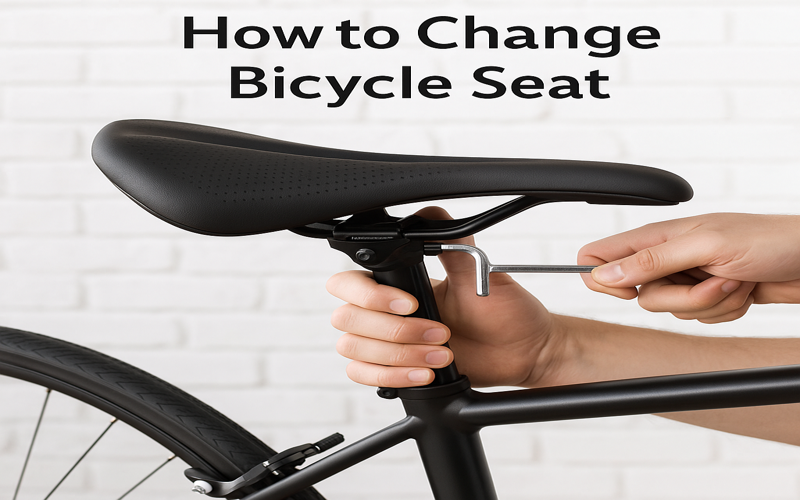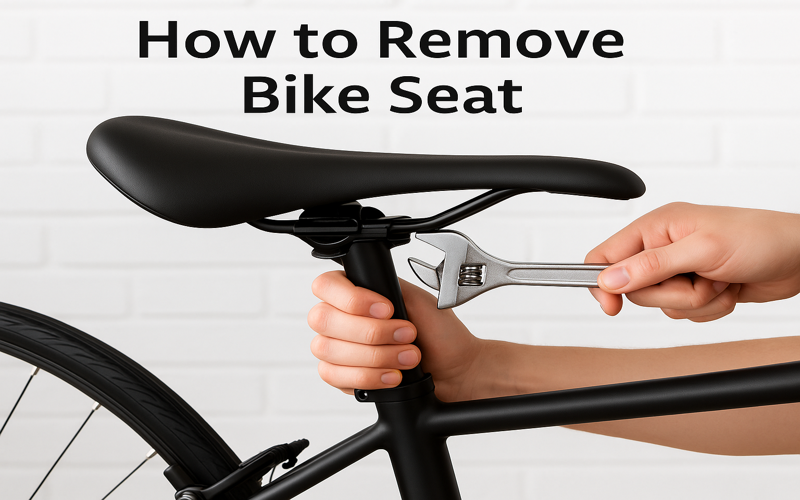Introduction
Knowing how to change a bicycle seat is an essential skill for any cyclist, whether you’re upgrading for comfort, switching to a new riding style, or replacing a worn-out saddle. A poorly fitted seat can lead to discomfort, saddle sores, and reduced performance, making it crucial to understand the process of removing and installing a new one correctly.
In this guide, you’ll learn step-by-step how to change a bike seat, including how to remove a bike seat from the post, and the difference between seatpost-mounted and rail-mounted saddles. We’ll also cover the tools you’ll need, comfort adjustments, and common mistakes to avoid.
Whether you’re dealing with a damaged saddle, adjusting your bike seat height, or simply exploring a better fit, this complete tutorial will walk you through the process smoothly—helping you ride more comfortably and confidently on every journey.

Table of Contents
Why You Might Need to Change Your Bicycle Seat
- Your existing saddle may be worn, cracked, or damaged from years of use, making it less effective in providing the support and comfort you need. A degraded saddle can lead to pain, imbalance, and reduced control while riding.
- You might be exploring a bicycle seat upgrade to enhance overall comfort or address persistent saddle pain. Modern saddles come in a variety of ergonomic shapes, padding types, and designs that help relieve pressure and improve endurance, especially on long rides.
- Your current saddle may not match your riding style, and switching to a seat designed for your specific discipline can make a big difference. Road cyclists, mountain bikers, commuters, and indoor riders all benefit from saddles tailored to their posture, weight distribution, and terrain type.
- If you’re frequently dealing with discomfort, numbness, or posture-related aches during or after your rides, it could be a clear sign that your saddle isn’t the right fit. Replacing it with a properly fitting model can dramatically improve your riding experience and help prevent long-term strain or injury.
Tools You’ll Need
- Allen wrench (typically 5mm or 6mm)
- Adjustable wrench or pliers (for older seat clamps)
- Grease or anti-seize compound (optional for seatpost maintenance)
- Clean rag for wiping the post and clamp
These basic bike maintenance tools will make it easier to handle your saddle replacement without a trip to the bike shop.
Step-by-Step Guide: How to Change a Bicycle Seat
a. How to Remove Bike Seat

- Find the seatpost clamp positioned at the upper end of your bike’s frame, where the saddle connects.
- Use an Allen wrench to loosen the bolt(s) on the clamp.
- Carefully pull the seat and post upward from the bike’s seat tube.
b. How to Remove Bike Seat from Post (if replacing saddle only)
- If you’re replacing just the saddle while keeping the existing seat post, start by identifying the mounting style. Most modern bicycles use a rail-mounted saddle system, where two parallel metal rails run beneath the seat. These rails fit into a clamp mechanism attached to the seat post.
- Start by securely positioning your bicycle on a repair stand or carefully flipping it upside down for better access. Locate the clamp underneath the saddle. Using the appropriate tool—usually a 5mm or 6mm Allen wrench—loosen the clamp bolts carefully. Take your time to ensure the bolts are loosened evenly to avoid damaging the clamp or rails.
- Once the bolts are loose enough, gently slide or lift the saddle rails out of the clamp. Be cautious not to force the rails, as bending or damaging them can affect the integrity of the new saddle.
- This step is essential when you want to replace only the saddle while keeping the current seat post intact. It allows for a smoother transition and ensures compatibility with your existing bike setup.
This step is key if you’re keeping your existing post and just swapping saddles.
c. Installing a New Bicycle Seat
- Align the new saddle’s rails within the seatpost clamp.
- Tighten the bolts gradually and evenly, checking alignment.
- Adjust the saddle angle (a level or slightly nose-down angle is typical).
- Set the correct saddle height before tightening fully.
- Test ride to ensure comfort and fine-tune as needed.
Adjusting the Seat for Comfort and Performance
- Set saddle height so your leg has a slight bend at full pedal extension.
- Set the saddle angle to level or tilt it slightly downward for optimal comfort.
- Slide the saddle forward or backward to align with your knee and pedal.
- Monitor for discomfort—it could mean misalignment or the wrong saddle type.
A well-fitted bike boosts comfort, improves efficiency, and helps prevent injuries.
Common Mistakes to Avoid
- Overtightening bolts can strip threads or damage components.
- Ignoring saddle angle often leads to numbness or pain.
- Choosing a saddle based on looks instead of fit and riding style.
- Skipping a test ride before long-distance cycling.
These beginner bike maintenance tips help you avoid costly errors.
Conclusion
Changing your bicycle seat is a simple but essential maintenance task that enhances comfort and performance. By understanding how to remove a bike seat, install a new one, and adjust it properly, you can tailor your ride to your needs. Don’t hesitate to try different saddles until you find the right fit—your body will thank you on every ride.
FAQs
Q1: What tools do I need to change my bike seat?
You typically need an Allen wrench, adjustable wrench, and a clean cloth. Some seatposts may also benefit from a touch of grease.
Q2: How do I know if my bike seat is too high or low?
If your hips rock while pedaling or you feel pressure on your knees, your saddle height likely needs adjustment.
Q3: Can I change my bike seat without removing the post?
Yes, if you’re only replacing the saddle, you can detach it from the post using the clamp under the seat.
Q4: Is it easy to switch a bike seat at home?
Yes, with basic tools and guidance, most cyclists can replace a saddle in under 15 minutes.
Q5: How often should I replace my bicycle saddle?
Every 1-3 years depending on usage, comfort level, and visible wear or damage.
